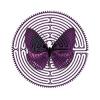

| Visitors Now: | |
| Total Visits: | |
| Total Stories: |

| Story Views | |
| Now: | |
| Last Hour: | |
| Last 24 Hours: | |
| Total: | |
KALARIPAYATTU: Experience the awesome acrobatics of this ancient martial art
This article was published in The Mindful Word journal of engaged living (http://www.themindfulword.org)
Kerala in southwestern India is known for its vibrant arts scene, in part because of the ancient martial art Kalaripayattu, known as one of the oldest martial arts, if not the oldest, which originated in this part of India.
Kalaripayattu is marked by high-flying acrobatics, fluid movements and weaponry. With lithe bodies, Kalaripayattu artists mimic the flowing movements of animals local to South India such as the tiger, elephant and snake.
Legends trace this mother of all martial arts back through early Hindu mythology to Sage Parasurama, known as one of the seven immortal humans in Hindu culture. More recently, in the 11th or 12th century AD it was first documented as being used in the war between the Chera and Chola dynasties in South India.
Attacks in this martial art include kicking, grappling and striking, both with weapons and without. The high jumps, leaps and graceful movements of kalaripayattu have predictably caught the attention of Bollywood, with the art form being incorporated into movies like Asoka, Lajja and even into Jackie Chan’s movie The Myth.
Beyond the lethal blows delivered by swords and sticks, warriors practicing kalaripayattu could knock out or even kill their enemies just by hitting specific marmam points on the body, which are the same vital points that form the basis of India’s ancient healing system, Ayurveda. Because of this advanced knowledge, kalaripayattu practitioners were also skilled in traditional medicine and massage, which was a necessary skill to learn when getting banged up so badly in combat or even just while training.
“Kalari” means school or gymnasium in the local Malayalam language of Kerala. “Payattu” means to fight or exercise. The martial art is embedded in the history of the region with these fight schools churning out warriors who would use the martial art to defend the king and kingdom.
The British banned kalaripayattu for fear of rebellion and anti-colonial sentiment, no doubt fearing its effectiveness. But it then went underground, resurfacing in the 1920s as part of a rediscovery of traditional arts in South India.
For travellers wanting to check out Kerala’s arts scene, Fort Kochi (also spelled “Fort Cochin”) offers a variety of entertainment options. Here there’s no problem finding kalaripayattu performances, which are not as common as the more widespread kathakali dances. The Kerala Kathakali Centre is one such place that offers daily performances in kalaripayattu as well as kathakali and Indian classical music and dance.
image 1 : smruti_damania (Creative Commons BY-SA) / image 2: Pondspider (Creative Commons BY-NC)
The post KALARIPAYATTU: Experience the awesome acrobatics of this ancient martial art appeared first on The Mindful Word.
Sign up for a free subscription to The Mindful Word\’s quarterly digital magazine at http://www.themindfulword.org/subscribe
2013-03-09 23:05:02
Source: http://www.themindfulword.org/2013/kalaripayattu-martial-art/
Source:




